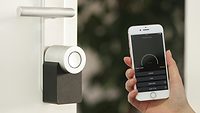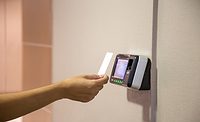Historically, access control has been based on guards, guns and keys. The primary purpose was to prevent things from happening — keep a bad guy from getting into the bank vault, a corporate spy accessing sensitive documents, a hacker getting into a server room or more.
Today, the entire philosophy of access control has changed. It is not about prohibiting the negative anymore, but instead about enabling fluid movement through spaces. With the growing digital transformation of physical spaces, access is now the ultimate enabler of letting people into spaces to make a business thrive, and it represents our first line of defense in protecting tenants’ health and safety in the fight against COVID-19.
Access control facilitates safe and hybrid work environments and the flexibility that both employers and employees are looking for in the workplace.
Access control can create safe and hybrid work environments
The transformation of the hybrid work model has completely turned commercial real estate on its head. To keep up with demands that are changing faster than the spaces themselves, cloud-based access control is the standard for enabling the office and commercial spaces for the post-COVID-19 era.
From the employer perspective, today’s corporate leaders are looking for a way back to the office. Research shows that 45% of companies expect to lead with a hybrid workforce model in the second half of 2021, and 32% indicated an “in-person first” employment model, according to a CNBC study. Based on this data, 77% of companies could be actively seeking solutions that will allow their employees to safely return to the office. To achieve this, access control becomes a foundational platform to help people access space in this new office environment.
Let’s talk safety. It’s impossible to discuss the return to work without factoring in tools that enable social distancing and occupancy limits.
Occupancy management as an access control element includes the ability to manage the total number of people on-site, including how many people are allowed within spaces inside the total office, such as office suites, conference rooms and other collaborative spaces. As more companies implement vaccine mandates, occupancy management also supports not only who should be allowed on-site, but also how many people are in a room at one time. And tools that support vaccine mandates are a critical need right now. Fifty-two percent of companies plan to have vaccine mandates by the end of the year, according to a Willis Towers Watson survey that polled 1,000 companies employing almost 10 million people.
Access control technology facilitates workplace optimization for employees by giving them a way to request the specific days they would like to be in the office, as well as the office stations and meeting rooms they require when on-site. While access control of the past included only provisioning into the main doorway, today’s access control includes the provisioning of all spaces, including desk booking and room reservations. Without access control connected to these types of systems, managing a hybrid or hoteling-type environment is nearly impossible. Visitor management is also imperative in the hybrid environment to know who enters in the event of mandatory contact tracing.
Lastly, for employers of large enterprises, cloud-based access control becomes critical when an organization has multiple locations. As each location reopens with varying hybrid models, the ability to manage every location and their specific needs all from the same place, and remotely, is imperative to ensure offices can run again.
The future of commercial real estate is flexibility
Intelligent access control technology provides a better tenant experience. In 2021, when 85% of the population owns a smartphone, it is safe to say that we are a mobile-first society. Mobile credentials allow tenants to utilize the smart devices they have on them at all times to provision access to where they want to go. From the garage through the main door to suite access, mobile access control creates a frictionless flow and improved tenant user experience.
Access control technology also provides the commercial real estate owner with more options for utilizing their property. Some property owners are adapting downsizing and available square footage in their buildings as a result of COVID-19 and the work shift. These adaptations include opening up more flex space or repurposing space into co-working areas, in which they can monetize their asset and take advantage of the new hybrid work model. To do this, however, access control is critical to managing these spaces and fully monetizing time and space used.
Access control data analytics powering space optimizations
Cloud-based access control has completely revolutionized data analytics for physical security by digitizing the collection, storage and management of each action collected. Knowing how your tenants access and use physical space helps you to make better decisions about how to optimize your physical footprint — you can’t manage what you can’t measure.
This level of detailed and granular data on people, places, things, video and events all together is a treasure trove of information that can be utilized for understanding micro and macro trends. On a micro level, the use of this data gives you a holistic view of how spaces are being used, who is using those spaces and where there are opportunities for efficiencies.
In the previously presented workplace optimization example, access control provides employees with the flexibility to book the days they want to return while simultaneously providing employers with a way to track how many people are wanting to return on a daily, weekly and monthly basis. The use of this data, when combined with organizations across the country, supports the tracking of macro trends over time, such as the status of the national return in a post-COVID-19 world.
In terms of physical safety, access control data makes security easier and more effective. The advanced analytics capabilities in cloud-based access control data sets help security teams weed through the thousands of actions that occur in a day and prioritize abnormal and risky activity to have faster response times to the activities that require additional attention.
Access control is enabling the future we want to see
It wasn’t that long ago that physical security was seen as an area that would be “nice” to update, but was not a priority for organizations. Today, that could not be further from the truth. The pandemic has completely reshaped working conditions and consumers’ and corporate health and safety concerns. The answer? Improved technology to support physical distancing and more granular access provisioning.
Security will always be about keeping people safe and ensuring assets are protected. But we need to evolve our thinking around access control just being used to badge in and out of a space. Access control is the foundation of a smart building tech stack that allows people the frictionless experience to welcome them back to the office.




